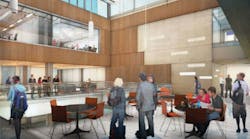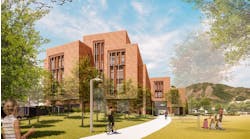About 50 years ago, as a surge in campus construction was underway, campus planners began to raise concerns about aging buildings. They noted that in the United States, more than 3,000 campuses would need to confront what to do with historic buildings. In retrospect, it is ironic: Any building constructed back then is old enough now to meet the 50-year threshold, a prerequisite for historic landmark status established by the Department of the Interior and the National Park Service. Clearly, the challenge has not subsided.
The retention, reuse, renovation or preservation of older facilities can be daunting, and sometimes a contentious topic at an institution. Is it more economical to build new space? Will the alumni react badly if an old, familiar structure disappears?
One concern not much considered five decades ago is sustainability. Rising interests in being green and limiting carbon emissions shape responses to the question of raze or reuse. A forward-looking point of view draws upon the disciplines of historic preservation and energy engineering to address the dilemma. Careful pre-planning is recommended; the answers are different for every institution.
Planning Approaches
One green trend sure to evolve into a widespread phenomenon is recycling by design.
Chatham University's most recent plan for its Woodland Road campus in Pittsburgh, Pa., did just that. New programs were sited at a satellite location with the renovation of a light-industrial building within a redeveloping urban district near the campus.
Campus buildings underwent study for activities that would best remain on the historic campus. Benefits include community outreach, economic reinvestment and a greener profile.
Focused recycling of redundant space also will gain greater currency, both in response to economic pressures and to advance conservation. Concordia College, Moorhead, Minn., built a new campus center that made dispersed dining halls obsolete. One of the vacated buildings was found suitable for renovation as academic space — a serendipitous finding as concurrent academic planning advanced to establish the curriculum for a school of business.
Renewal and Preservation
The balance of tradition and innovation is a prevailing ethos at most education institutions. Furthermore, the stewardship of historic campus buildings and landscapes is fundamental to ensuring the continuity of tradition.
In a world of diminishing resources and global warming, the creative practice of preservation — as a discipline that manages change with an eye to both past and future — also can stand for environmental innovation.
Reuse of historic facilities often is challenged by those who contend that new construction would be more cost-effective. Yet, the reuse of structure and building shell, even assuming a gut renovation, can save about one-third of the construction cost for an equivalent magnitude of new space. Still, the restoration of historic materials and details are expenses that may increase a construction budget, so costs need to be balanced with other factors.
In recent years, branding has emerged as a mantra for corporations and institutions. Education institutions now recognize how much the value of a unique brand is embodied in the memories associated with its historic resources.
From prospective students to alumni returning for a 50th reunion, the sense of place that the buildings and landscape evoke is a powerful draw.
Effective heritage planning is approached with holistic goals in mind, while paying careful attention to detail.
The initial step is a comprehensive survey that identifies, describes and ranks the significance of every component of the built environment. Conditions assessments are done in parallel to identify maintenance priorities that can be factored into appropriate planning and design strategies for ongoing upkeep and capital improvement.
In tandem, these efforts enable the institution to better understand the spectrum of what their resources mean — to better leverage the original meanings and purposes and how they might be reinforced or appropriately transformed.
Guidelines informed by the findings of the initial assessments help establish a framework for deciding about the renewal of buildings as a whole, features within the buildings, and landscapes. These guidelines need to be clear, flexible, but subject to being rigorously referenced to attain the vision intended.
Guidelines that are founded on a critical analysis and clear vision of what is important to historical character will indicate how the physical characteristics of a building suggest optimal reuses, as well as where potential additions would be situated.
The examination of any building enables the development of parameters for preservation and reuse, particularly with respect to issues such as structural bay sizing, loading capacity and floor-to-floor heights.
In some cases, significant interior spaces will dictate preservation for particular new uses. For other buildings, a more robust approach to renovation can alter the interior radically, even while endowing the character of the original construction with new purpose.
Expending Energy
Although renovating or repurposing an historic building may seem intimidating, a methodical approach — using the right team and resources — streamlines the process of evaluating alternative strategies.
When properly upgraded, older buildings are not necessarily less energy-efficient than new construction. By avoiding the production impacts of new building materials and reducing possible demolition and construction activity, building renewal almost certainly yields a net benefit in terms of energy use and greenhouse gas (GHG) emissions.
Understanding the original design intent, condition and systems establishes a foundation for analyzing best-fit reuse and renewal. Additionally, energy history from utility meters (or sub-meters in a campus environment) can inform future projections.
Once a plan for future use is established, it is essential to determine the services and conditions required, including the energy and sustainability goals that will guide design. The addition of air conditioning, for example — a common decision early in this process — brings with it the benefit of humidity control in summer but more restrictive mechanical system choices, as well as greater energy consumption in most cases.
The decisionmaking process should consider energy-efficiency opportunities and how they interact with preservation priorities. In a recent higher-education project involving large, historic residences with no wall insulation, the removal and reconstruction of many interior walls to install insulation increased energy efficiency and enabled multiple systems (information technology, life safety) to be incorporated more easily and seamlessly. However, in key spaces of particular historical character, alternative strategies retained the interior walls and accepted a lower insulation value.
Installation of new technologies may achieve greater sustainability in existing buildings with less disruption. New fluorescent lamp-ballast combinations are excellent for general lighting. LED lights offer long life (especially for hard-to-reach areas) and low heat output. Replacing aged lighting has the compound benefit of reducing cooling loads.
For heating only (without air conditioning), condensing boilers can operate at 90 to 95 percent efficiency (a gain of 10 to 15 percent over older technology) and do not require unsightly or hard-to-route vent stacks. Heat pumps or variable refrigerant-flow heating/cooling systems are another low-GHG option, particularly when combined with wells for earth coupling.
Effective controls are essential to optimizing all building systems (lighting, heating, cooling, ventilation) to deliver what is needed when spaces are in use. Occupancy sensors, CO2 monitoring, and even simple time clocks all have their places in an energy-reduction strategy. Where running wires is impractical or would adversely affect a historic space, controls and monitors now can be combined with wireless devices.
Modern software and analytic tools that project future energy use and GHG emissions are powerful tools to supplement the experience of professionals with the ability to model and review a project's "what-if" scenarios. Even when not required for LEED or other certifications, energy modeling and thermal (dew point) analysis contribute to more effective designs, avoid unpleasant surprises and advance sustainable design principles.
Craig, LEED AP, is senior master planner; Fixler, FAIA, LEED AP, is a historic preservation expert; and Kennedy, PE, CEM, LEED AP, is energy sector leader with EYP Architecture & Engineering, which has offices nationwide. Craig can be reached at [email protected] . Fixler can be reached at [email protected] . Kennedy can be reached at [email protected].


